Toyota 2015 Annual Report Download - page 194
Download and view the complete annual report
Please find page 194 of the 2015 Toyota annual report below. You can navigate through the pages in the report by either clicking on the pages listed below, or by using the keyword search tool below to find specific information within the annual report.-
 1
1 -
 2
2 -
 3
3 -
 4
4 -
 5
5 -
 6
6 -
 7
7 -
 8
8 -
 9
9 -
 10
10 -
 11
11 -
 12
12 -
 13
13 -
 14
14 -
 15
15 -
 16
16 -
 17
17 -
 18
18 -
 19
19 -
 20
20 -
 21
21 -
 22
22 -
 23
23 -
 24
24 -
 25
25 -
 26
26 -
 27
27 -
 28
28 -
 29
29 -
 30
30 -
 31
31 -
 32
32 -
 33
33 -
 34
34 -
 35
35 -
 36
36 -
 37
37 -
 38
38 -
 39
39 -
 40
40 -
 41
41 -
 42
42 -
 43
43 -
 44
44 -
 45
45 -
 46
46 -
 47
47 -
 48
48 -
 49
49 -
 50
50 -
 51
51 -
 52
52 -
 53
53 -
 54
54 -
 55
55 -
 56
56 -
 57
57 -
 58
58 -
 59
59 -
 60
60 -
 61
61 -
 62
62 -
 63
63 -
 64
64 -
 65
65 -
 66
66 -
 67
67 -
 68
68 -
 69
69 -
 70
70 -
 71
71 -
 72
72 -
 73
73 -
 74
74 -
 75
75 -
 76
76 -
 77
77 -
 78
78 -
 79
79 -
 80
80 -
 81
81 -
 82
82 -
 83
83 -
 84
84 -
 85
85 -
 86
86 -
 87
87 -
 88
88 -
 89
89 -
 90
90 -
 91
91 -
 92
92 -
 93
93 -
 94
94 -
 95
95 -
 96
96 -
 97
97 -
 98
98 -
 99
99 -
 100
100 -
 101
101 -
 102
102 -
 103
103 -
 104
104 -
 105
105 -
 106
106 -
 107
107 -
 108
108 -
 109
109 -
 110
110 -
 111
111 -
 112
112 -
 113
113 -
 114
114 -
 115
115 -
 116
116 -
 117
117 -
 118
118 -
 119
119 -
 120
120 -
 121
121 -
 122
122 -
 123
123 -
 124
124 -
 125
125 -
 126
126 -
 127
127 -
 128
128 -
 129
129 -
 130
130 -
 131
131 -
 132
132 -
 133
133 -
 134
134 -
 135
135 -
 136
136 -
 137
137 -
 138
138 -
 139
139 -
 140
140 -
 141
141 -
 142
142 -
 143
143 -
 144
144 -
 145
145 -
 146
146 -
 147
147 -
 148
148 -
 149
149 -
 150
150 -
 151
151 -
 152
152 -
 153
153 -
 154
154 -
 155
155 -
 156
156 -
 157
157 -
 158
158 -
 159
159 -
 160
160 -
 161
161 -
 162
162 -
 163
163 -
 164
164 -
 165
165 -
 166
166 -
 167
167 -
 168
168 -
 169
169 -
 170
170 -
 171
171 -
 172
172 -
 173
173 -
 174
174 -
 175
175 -
 176
176 -
 177
177 -
 178
178 -
 179
179 -
 180
180 -
 181
181 -
 182
182 -
 183
183 -
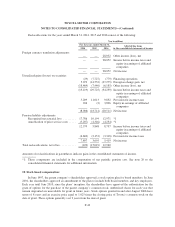 184
184 -
 185
185 -
 186
186 -
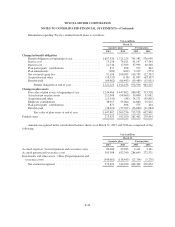 187
187 -
 188
188 -
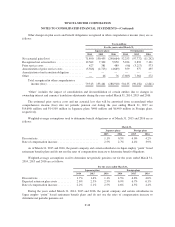 189
189 -
 190
190 -
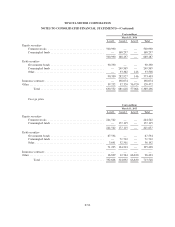 191
191 -
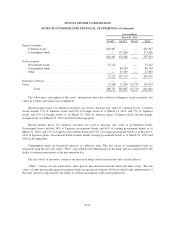 192
192 -
 193
193 -
 194
194 -
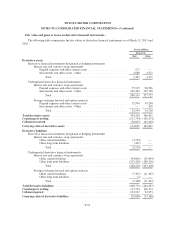 195
195 -
 196
196 -
 197
197 -
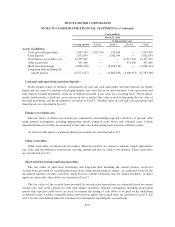 198
198 -
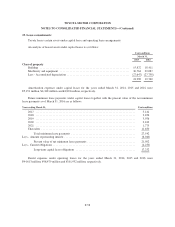 199
199 -
 200
200 -
 201
201 -
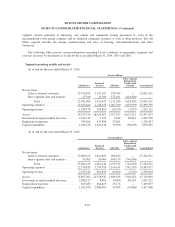 202
202 -
 203
203 -
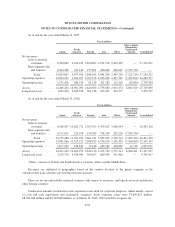 204
204 -
 205
205 -
 206
206 -
 207
207 -
 208
208 -
 209
209 -
 210
210 -
 211
211 -
 212
212 -
 213
213 -
 214
214 -
 215
215 -
 216
216 -
 217
217 -
 218
218 -
 219
219 -
 220
220 -
 221
221 -
 222
222 -
 223
223 -
 224
224 -
 225
225 -
 226
226 -
 227
227 -
 228
228
 |
 |
TOYOTA MOTOR CORPORATION
NOTES TO CONSOLIDATED FINANCIAL STATEMENTS—(Continued)
Postretirement benefits other than pensions and postemployment benefits -
Toyota’s U.S. subsidiaries provide certain health care and life insurance benefits to eligible retired
employees. In addition, Toyota provides benefits to certain former or inactive employees after employment, but
before retirement. These benefits are provided through various insurance companies, health care providers and
others. The costs of these benefits are recognized over the period the employee provides credited service to
Toyota. Toyota’s obligations under these arrangements are not material.
21. Derivative financial instruments:
Toyota employs derivative financial instruments, including foreign exchange forward contracts, foreign
currency options, interest rate swaps, interest rate currency swap agreements and interest rate options to manage
its exposure to fluctuations in interest rates and foreign currency exchange rates. Toyota does not use derivatives
for speculation or trading.
Fair value hedges -
Toyota enters into interest rate swaps and interest rate currency swap agreements mainly to convert its
fixed-rate debt to variable-rate debt. Toyota uses interest rate swap agreements in managing interest rate risk
exposure. Interest rate swap agreements are executed as either an integral part of specific debt transactions or on
a portfolio basis. Toyota uses interest rate currency swap agreements to hedge exposure to currency exchange
rate fluctuations on principal and interest payments for borrowings denominated in foreign currencies. Notes and
loans payable issued in foreign currencies are hedged by concurrently executing interest rate currency swap
agreements, which involve the exchange of foreign currency principal and interest obligations for each functional
currency obligations at agreed-upon currency exchange and interest rates.
For the years ended March 31, 2014, 2015 and 2016, the ineffective portion of Toyota’s fair value hedge
relationships was not material. For fair value hedging relationships, the components of each derivative’s gain or
loss are included in the assessment of hedge effectiveness.
Undesignated derivative financial instruments -
Toyota uses foreign exchange forward contracts, foreign currency options, interest rate swaps, interest rate
currency swap agreements, and interest rate options, to manage its exposure to foreign currency exchange rate
fluctuations and interest rate fluctuations from an economic perspective, and for some of which Toyota is unable
to or has elected not to apply hedge accounting.
F-53
